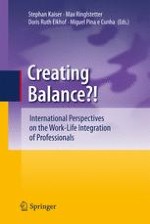2011 | OriginalPaper | Chapter
15. The “Myth of Separate Worlds”: An Exploration of How Mobile Technology has Redefined Work-Life Balance
Authors : Linda Duxbury, Rob Smart
Published in: Creating Balance?
Publisher: Springer Berlin Heidelberg
Activate our intelligent search to find suitable subject content or patents.
Select sections of text to find matching patents with Artificial Intelligence. powered by
Select sections of text to find additional relevant content using AI-assisted search. powered by
